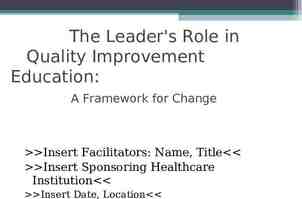Medical Workforce – Medical Support Workers Programme Mr Thomas
7 Slides300.50 KB

Medical Workforce – Medical Support Workers Programme Mr Thomas Kearney NHS England and NHS Improvement

Introduction Consider medical workforce Gap Context of current mitigations Specific Programmes and Priorities for a strategic medical workforce team (currently doesn’t exist) HEI SR Bid for Higher training places MSWs pilot and initial findings Recommendations 2 Item Time Welcome and Purpose of Steering Committee 5 minutes Key Considerations: Overview of Medical WF Supply Function Current Challenges and Gap Scenario for MSWs Cost per Strand of Current Doctor Training - 15 minutes For Discussion: Retention and Recommendations Funding Position - 35 minutes Conclusion 5 minutes

Workforce demand-supply forecast - SR settlement scenario (FY 24/25), FTE (000s) Green Greenindicates indicateswhere whereinitiatives initiatives contribute contributeto toclosing closingthe thegap gap Group Medical 3 Sub-group Consultant Other doctors Doctors in training GPs Adult Nursing Initiatives Initiativesupskill upskillsignificant significant FTE FTEin inunderstaffed understaffedareas areas Additionalcapacitycreatedby Additional FTEs Gapincreased Current Current Gap(Do nothing, 24/25) Gap(Do something, 24/25) profs/progs(24/25) upskiledby comparedto supply gap FTE %ofsupply FTE %ofsupply FTEs %ofsupply profs/progs(24/25) today 51.7 4.6 25.0 0.5 24.4 0.5 36.2 3.5 239.7 25.2 4.0 1.5 1.2 0.6 14.3 6.7% 6.1% 5.0% 1.5% 5.5% 3.9 6.6% 1.5 6.0% (3.3) -13.4% 0.6 1.5% 13.0 5.0% 0.1 0.0 4.5 1.3 0.1% 0.1% 18.4% 0.0% 0.5% 1.1 0.1 10.1 Yes

Current MSW progress Region Currently Employed: To be employed by 11 October 2021: London South East Midlands North West South West East of Engl and North East & Yorkshire Total 110 45 45 11 10 16 110 45 67 30 99 16 12 12 249 379 By October 11, there will be 379 employees on the Medical Support Worker programme exhausting the full budget set by DHSC . 4

Savings made by employing MSWs Cost saving to develop Doctors Time Saving to develop Doctors 600,000 500,000 Medical support workers 311,948.00 201,051.45 400,000 300,000 200,000 Upskilling 513,000.00 100,000 0 Average cost Saving 5 Cost to train to ST7 Graduation FY1 FY2 Upskilling ST3 ST4 ST5 ST6 Medical support workers The average MSW employee enters the programme on ST4 level. This would save the NHS 311k and over 7 years in comparison to upskilling to ST7 level. In addition, the MSW programme will save XXXX per year with 500 MSW’s employed. ST7

Gaps in workforce Over the next 3 years, the MSW can employ c.1700 employees. Workforce gaps 5 4.5 This would be split into 500 consultants, 1000 Doctors in training and 200 GPs. 4 3.5 3 This would reduce the gap in workforce from a predicted 5,800 to 4,100. 2.5 2 1.5 1 0.5 0 Consultant Doctors in training Current Gap (1,000) 6 Gap in 2024/25 (1,000) Gap in 2024/25 with MSW (1,000) GPs

Summary The position around medics and particular specialities in concerning and will affect flow and recovery The extension of medical training places will have an impact on specialities but this is a longer term gain and will not help recovery in the medium term There are key actions recommended from the position which have been put forward in the SR such as MSWs and policy reviews and changes which are intended as interventions as medical shortfall and leaver rates This requires an integrated approach across various programmes which will need to be coordinated These integrated strategic approaches around policy and targeting need to be bespoke based on regional variation of medical shortfalls Integration of approach needs to be across gateway, MSWs, Landmark and overseas recruitment programme from HEE These approaches across retention, overseas recruitment and refugee programmes will require central coordination The yield against shortfall can be significant in the region of 2,000 medics at mid level training place fulfilment for MSWs by 2025 The yield for UK national recruitment could be as high as 600 by 2025 The yield for retention would need to be looked at by region and ICS and focus on speciality shortfall MSW candidates so far have exited the programme at average ST5 level which means costs likely to training to consultant including MSW year are c 200k to consultant level. Undergrad medical training for the same number 500 across training to consultant level are 513k Per 500 cohort MSW the saving alone assuming average of ST5 training is maintained is 313k x 500 156.5M per year in training saved in the medium term. Variation to MSW average entry @ ST3 (assuming worst case scenario) the saving will still be 106.5million per year based on 500 candidates 7





